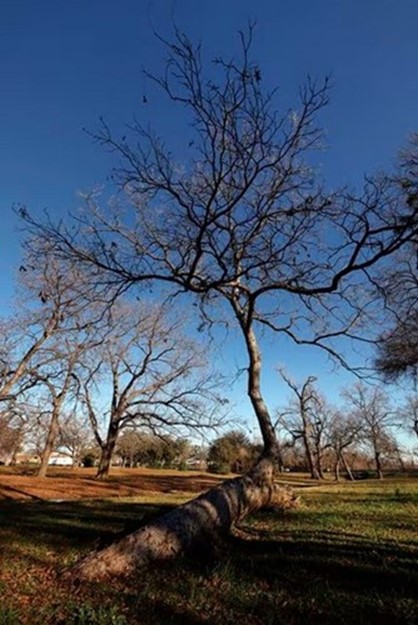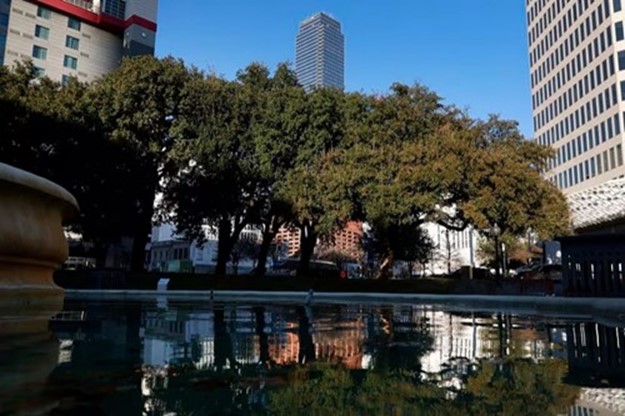Dallas Takes an Unprecedented Step to Save Its Historic Trees — and We All Missed It


Dallas Takes an Unprecedented Step to Save Its Historic Trees — and We All Missed It
Now Residents Need to Get Busy and Nominate More of These Marvels of Nature for Similar Protections.
Published January 11, 2024, By SHARON GRIGSBY
Dallas stood up for its granddaddy trees, and we all missed it.
Everyone, that is, except for the handful of folks who for five years pushed and prodded the preservation project toward its big day at City Hall. Finally, in a first for North Texas, the Dallas City Council voted to formally protect 86 historically significant trees.
Look back at the calendar and it’s understandable why this big arbor victory on Oct. 25 went unnoticed. We were out of our minds over another first — a World Series featuring our own Texas Rangers.
Yet given how much we wail any time trees, especially the old majestic ones, are in danger, the City Council’s action deserves a headline. Maybe the news will prompt you to consider other trees that need to be nominated for protection. Or, for those of you who live outside Dallas, to lobby your city to put a similar ordinance in place.
The trees designated historic include the iconic and the invisible. The Live Oaks and Cedar Elms at Dealey Plaza. The Post Oaks near the convention center. A Comanche Marker Tree in northwest Dallas. The Pecans in Oak Cliff’s Moore Park.
The historic designations are important both as a symbolic honoring of these marvels of nature and as a reminder of their practical importance to our environment. “These old trees have guided generations of Texans and now provide tremendous environmental benefits,” City Council member Kathy Stewart, chair of the Parks, Trails and Environment Committee, said when we talked about the vote.

Large Post Oaks, some of them more than 250 years old, in Pioneer Park Cemetery, adjacent to the Kay Bailey Hutchison Convention Center and Pioneer Plaza in downtown Dallas. (Tom Fox / Staff Photographer)
The classification, created in the 2018 overhaul of the tree ordinance, refers to a tree or grove of trees recognized as having cultural or historical significance. Except in cases of the tree dying and posing a threat, cutting it down would require City Council approval.
Phil Erwin, the city’s chief arborist, and the Texas Historic Tree Coalition, especially founding member and current trustee Steve Houser, are the green giants who led the way to get this work done.
“The trees are important in how Dallas remembers itself,” Erwin told me. “We need to recognize those last bastions of the history of Dallas. They record the time for us.”
Houser reminded me it’s not just about history. Trees mitigate climate change by removing carbon dioxide from the air, storing carbon in the trees and soil, and releasing oxygen into the atmosphere. Large and old trees provide up to 70% more environmental benefits than do newly planted or smaller trees that — if they are lucky enough to survive — will help sometime down the road.
Protected historic trees in Dallas

“Economic development is important,” Houser said, “but it should not compromise our environment or our children’s personal health and future well-being.”
October’s designation of multiple locations of historic trees follows the effort of north Oak Cliff resident Katherine Homan, herself a force of nature, to win similar approval for the West Dallas Gateway Pecan. As city staff and tree advocates navigated the technicalities involved in implementing the historic designation process, Erwin and Houser used the West Dallas Pecan as a test case.
The latest historic designations include three large groves of trees as well as three individual ones:
The Big Spring Bur Oak, on the edge of the Great Trinity Forest and alongside the historic Big Spring, is believed to be at least 235 years old. Even before the founding of Dallas, it provided shade for American Indians and pioneer families.
Another Bur Oak, the Cherokee Park Tree, sits in the middle of Old City Park near downtown, a spot that served as a campsite during the days of the Texas Republic.

Pictured above right: The California Crossing Comanche Marker Tree in northwest Dallas, photographed Tuesday. (Tom Fox / Staff Photographer)
The California Crossing Comanche Marker Tree, a Pecan more than 150 years old in far northwest Dallas, is bent with a significant portion of the trunk under the soil. Its name refers to a low-water Trinity River crossing used by American Indians as well as early settlers.
I’ve long known the history of the Post Oaks that cast their shadows over early Dallas leaders’ graves at Pioneer Park Cemetery and the Live Oaks and Cedar Elms at Dealey Plaza, forever linked to the assassination of President Kennedy. The historically designated Dealey trees are in the center of the plaza behind the pools and on the north side between the Sixth Floor Museum and the plaza.
I knew far less about the Big Tree Grove at Moore Park, originally known as the Eighth Street Negro Park when it became part of the city’s segregated green spaces in 1938. The park was rededicated in 1940 and named for early civil rights leader Will Moore during a Juneteenth celebration that honored the handful of surviving community members who previously had been enslaved.
Marion Lineberry, the Texas Historic Tree Coalition president, shared the history with me and noted Chris McMaster, city forester in the park department, deserves credit for bringing these trees to the group’s attention.
In its earliest days, the park featured games played by the Dallas Negro Amateur Baseball League. The still popular green space, some of its trees now approaching 200 years old, continues to host community celebrations and civic meetings as well as barbecues and picnics.
Lineberry expects the October historic designations to spark more nominations. Next on the coalition’s list are the Live Oaks in downtown’s Ferris Plaza and more Indian marker trees.

The Live Oaks in Ferris Plaza are seen reflected in the park's fountain in downtown Dallas on Tuesday. The Texas Historic Tree Coalition hopes to get historic designations for these trees in the coming months. (Tom Fox / Staff Photographer)
“We’ve shown it can be done,” Lineberry said, “and that may lead to private property owners who may want to submit their trees for historic designation.”
You might think the trees most recently designated as historic don’t need protection, given they are on city-owned land. “Leadership and people, even at the park and recreation office, change,” Lineberry said. “That means somebody someday might have a completely different park project that could involve the area where the trees stand.”
The trees’ new classification makes such a plan far more formidable because constituents would likely — and loudly — be in contact with their council representatives.
The October vote was unanimous, and City Council member Jaynie Schultz told those in attendance she hoped the historic designations are a trend that expands throughout Dallas.
When we talked about the council action a few days ago, Schultz drew a comparison between the preservation of architecturally and culturally significant structures and the preservation of trees. “You can’t talk about saving buildings and their stories without doing the same for the trees,” she said.
Trees make us happy, I always say, plus they provide environmental and economic benefits that become more important every day. That’s why, even if the applause comes three months late, everyone who had a hand in protecting these historic trees deserves our thanks.
Now let’s get busy figuring out which trees deserve the next nominations for historic designation and protection.
For more information, check out the City of Dallas Forestry Historic Trees and Neighborhood Forest Overlay page and the Texas Historic Tree Coalition website.
City of Dallas Historic Tree Nomination Form Guidelines and Instructions
